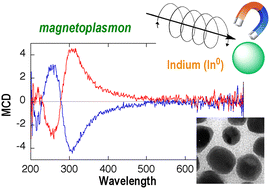UV-resonant magnetoplasmonic properties of chemically synthesized indium nanoparticles†
Abstract
In this article, we for the first time demonstrate magnetoplasmonic properties of metallic indium (In0) nanoparticles, one of the promising non-noble metals for UV plasmonics, by using magnetic circular dichroism (MCD) spectroscopy. In0 nanoparticles are synthesized by a kinetically controlled reduction of indium salts, followed by performing centrifugation-based size selection, giving nanoparticles of 37.5 ± 9.7 or 51.6 ± 8.4 nm in diameter. These In0 nanoparticles exhibit a single extinction peak in the UV region (<300 nm), which can be attributed to localised surface plasmon resonance (LSPR), and upon increasing the particle size, the peak is red-shifted and broadened. The MCD signatures are then typical for circular magnetoplasmonic modes of metal nanospheres, and on the basis of the MCD responses, the effective mass of an electron (m*) of indium is estimated. Interestingly, although the large-sized In0 nanoparticles (51.6 nm) have a broader LSPR linewidth, the magneto-optical (MO) activity is larger than that of the smaller one (37.5 nm), which is unlike the behaviour of Ag nanospheres with high-quality-factor plasmonic performance. This can probably be due not only to the formation of stiff semiconducting (In(OH)3) shell layers on the In0 cores (= In0@In(OH)3 core–shell morphology) but also to the effect of the dielectric function of In0 that can influence the light-helicity-dependent field-induced cyclotron shift.



 Please wait while we load your content...
Please wait while we load your content...